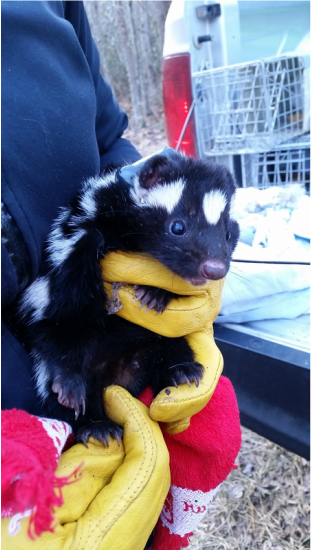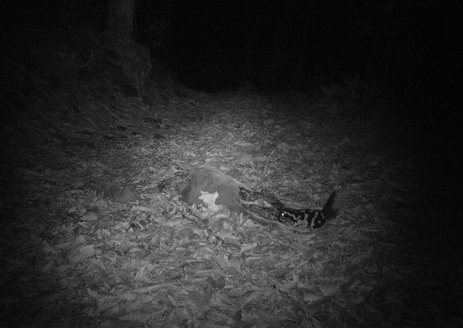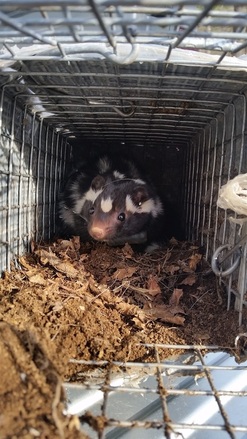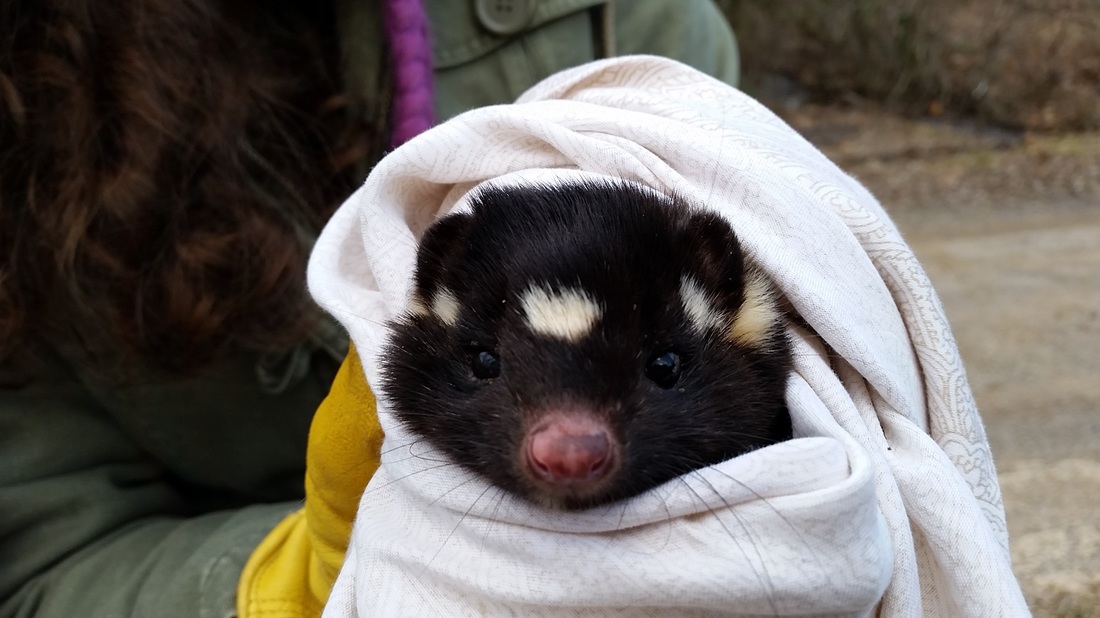 Captured spotted skunk. Photo by Emily Thorne.
Captured spotted skunk. Photo by Emily Thorne.
What is a spotted skunk?
At first glance a spotted skunk can easily be mistaken as a “funny-looking” striped skunk with their striking black and white coloration and unmistakable odor. However, if you are lucky enough to get a long look at this creature it quickly becomes obvious that what you are looking at is not a run-of-the mill “polecat” in rural parlance. Their distinct 4 to 6 broken white bands, weasel-like size and shape, quick and agile movements, and ability to climb trees like a squirrel with big stink distinguishes them from the larger, lackadaisical striped skunk.
Spotted skunks are small but fierce predators. Maxing out at approximately one to two pounds, this species feeds on a variety of prey including insects, amphibians, reptiles, birds, bats, and small rodents as well as soft mast. Unlike striped skunks, its feet are specialized for climbing rather than digging which allows them to search for food in trees and use tree cavities for dens. However, spotted skunks are no strangers to the ground and will regularly den in underground burrows, rocky crevices and hollow logs or tree stumps. What little is known about them comes mostly from the Deep South where spotted skunks seem to be associated with habitats with thick ground cover such as newly regenerating forests, oldfields, vine-choked bottomland hardwood swamps and sub-tropical prairies with saw palmetto (Serenoa repens) thickets.
In Virginia, the spotted skunk can be found in the Appalachians spanning from Frederick County to the top of Whitetop Mountain in the Mount Rogers National Recreation Area in Grayson County as well as occasionally in the Piedmont just east of the Blue Ridge. They are currently listed as “vulnerable” in Virginia and have been largely absent from the landscape over the last few decades.
 Spotted skunk at baited camera trap. Image by Emily Thorne.
Spotted skunk at baited camera trap. Image by Emily Thorne.
The Virginia Department of Game and Inland Fisheries has partnered with the Virginia Tech Department of Fish and Wildlife Conservation and the U.S. Geological Survey, Virginia Cooperative Fish and Wildlife Research Unit to learn more about spotted skunks in the Old Dominion. The goals of this research are to determine the current range of this species in Virginia and to identify its habitat preferences. In 2014 our team began a baited camera trap study in the central and southern Appalachian Mountains of western Virginia. From January through April over the last three years, we have deployed remote sensing trail cameras baited with road-killed deer in over 100 locations throughout the George Washington and Jefferson National Forest, along the Blue Ridge Parkway, on state lands and on cooperating private lands. Spotted skunks were “caught” on camera at 22 of these locations. We compared occupied and unoccupied sites to a variety of landscape and habitat features including forest type and age, percent canopy cover, elevation, distance to roads and waterways, and distance to agricultural and residential areas.
Surprisingly, spotted skunks showed a preference for both low elevation, early- to mid-successional forests as well as high elevation, mature to old growth forests. Though functionally and ecologically different, young and old growth forests are both characterized as having complex forest structure. High woody stem densities in younger forests and mature mountain laurel (Kalmia latifolia) and rhododendron (Rhododendron maximum) thickets found in old growth forests provide spotted skunks with protective cover from aerial predators, such as great horned owls (Bubo virginianus), while foraging and rearing young. These findings, along with several recent reports of spotted skunks at low elevations east of the Blue Ridge, have demonstrated the need to expand our study eastward to identify the current boundaries of this species’ range in Virginia.
 Spotted skunk in live trap. Image by Emily Thorne.
Spotted skunk in live trap. Image by Emily Thorne.
ed and radio collared spotted skunks to determine individual home range size and to better understand movement patterns, den selection, reproduction and the genetic relationships within and among skunk populations. Our goal is to use this information to develop effective conservation assessments and management plans for this captivating yet little known species.
How can the Master Naturalist get involved?
Because so little is known about the distribution of eastern spotted skunks, our study relies heavily on reported sightings, trail camera photos, and reports of spotted skunk road-kills by the public to locate potential trap sites. Master Naturalists can help by spreading the word about eastern spotted skunks and contacting Emily Thorne, Virginia Tech graduate student and head researcher on the Virginia Eastern Spotted Skunk Project, at edthorne@vt.edu with information about confirmed sightings. Valuable information includes date and time sighting occurred, exact location (GPS location if possible), name and contact information of the landowner, and photo(s) if available.
We will be holding a Continuing Education webinar for VMN volunteers on September 28 that will focus on spotted skunks and how VMNs can contribute to this research. Watch our Continuing Education page for details.

